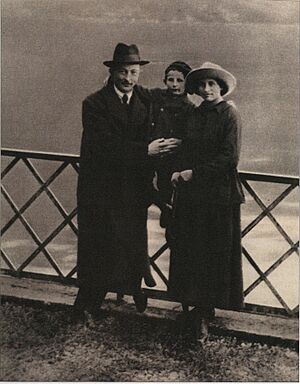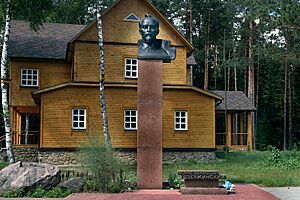Felix Dzerzhinsky facts for kids
Quick facts for kids
Felix Dzerzhinsky
|
|
|---|---|
|
Феликс Дзержинский
|
|
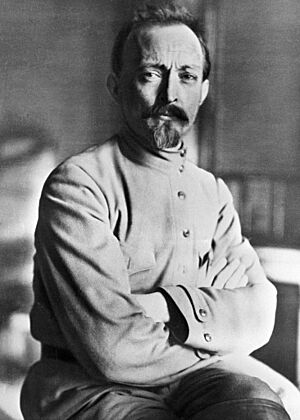
Dzerzhinsky in 1918
|
|
| Chairman of the OGPU | |
| In office 15 November 1923 – 20 July 1926 |
|
| Premier | |
| Preceded by | Himself as Chairman of the GPU |
| Succeeded by | Vyacheslav Menzhinsky |
| Chairman of the GPU | |
| In office 6 February 1922 – 15 November 1923 |
|
| Premier | Vladimir Lenin |
| Preceded by | Himself as Chairman of the Cheka |
| Succeeded by | Himself as Chairman of the OGPU |
| Chairman of the Cheka | |
| In office 20 December 1917 – 6 February 1922 |
|
| Premier | Vladimir Lenin |
| Preceded by | Office established |
| Succeeded by | Himself as Chairman of the GPU |
| People's Commissar of VSNKh | |
| In office 2 February 1924 – 20 July 1926 |
|
| Premier | Alexei Rykov |
| Preceded by | Alexei Rykov |
| Succeeded by | Valerian Kuybyshev |
| Candidate member of the 13th, 14th Politburo | |
| In office 2 June 1924 – 20 July 1926 |
|
| Member of the 6th Secretariat | |
| In office 6 August 1917 – 8 March 1918 |
|
| Personal details | |
| Born |
Feliks Dzierżyński
11 September [O.S. 30 August] 1877 Dzerzhinovo estate, Minsk Governorate, Russian Empire |
| Died | 20 July 1926 (aged 48) Moscow, Russian SFSR, Soviet Union |
| Resting place | Kremlin Wall Necropolis, Moscow |
| Nationality | Polish |
| Political party | VKP(b) (from 1917) |
| Other political affiliations |
|
| Spouse |
Zofia Sigizmundovna Muszkat
(m. 1910) |
| Children | Jan Feliksovich |
| Signature | |
Felix Edmundovich Dzerzhinsky (born September 11, 1877 – died July 20, 1926) was a famous Soviet revolutionary and politician. He was from Poland and was often called "Iron Felix" because of his strong will. From 1917 until his death, he led the first two Soviet secret police groups, the Cheka and the OGPU. He helped set up these important security groups for the Bolsheviks, who were the ruling party.
Dzerzhinsky was born into a Polish noble family in what is now Belarus. He became interested in politics at a young age. He joined revolutionary groups that wanted to change society. He was often arrested and sent away to Siberia, but he always managed to escape. He even studied the methods of the old Russian secret police, the Okhrana. Dzerzhinsky took part in the Russian Revolution of 1905, which failed. After another arrest in 1912, he stayed in prison until the February Revolution of 1917. After being freed, he joined Vladimir Lenin's Bolshevik party. He played a big part in the October Revolution, which brought the Bolsheviks to power.
In December 1917, Lenin chose Dzerzhinsky to lead the new All-Russia Extraordinary Commission, known as the Cheka. His job was to stop anyone who was against the new Soviet government. During the Russian Civil War, the Cheka became very powerful. It was known for taking strong actions against those seen as enemies. The Cheka was later changed into the State Political Directorate (GPU) in 1922. A year later, it became the Joint State Political Directorate (OGPU). Dzerzhinsky remained in charge of this powerful organization. From 1924, he also led the Supreme Soviet of the National Economy (VSNKh), which managed the country's economy.
Dzerzhinsky died from a heart attack in 1926. He was buried in the Kremlin Wall Necropolis in Moscow. Many secret police agents, called "Chekists," saw him as a hero. A large statue of him stood in front of the security service building in Moscow until 1991. However, to others, he became a symbol of strict control and harshness.
Contents
Felix Dzerzhinsky: A Life of Change
Early Life and Family
Growing Up in the Russian Empire
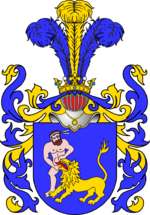
Felix Dzerzhinsky was born on September 11, 1877. His parents were Polish and came from a noble family. He was born at the Dzerzhinovo family estate. This place is about 15 miles (24 km) from a town called Ivyanets. It was in the Minsk Governorate of the Russian Empire, which is now Belarus. His family was known as "column-listed nobility." This meant their noble status was old and recognized.
Felix had a sister named Wanda who died at age 12. She was accidentally shot with a hunting rifle on their family estate. It was unclear if Felix or his brother Stanisław was responsible for the accident.
His father, Edmund-Rufin Dzierżyński, finished university in 1863. He then worked as a teacher in different cities. In 1875, he retired because of his health. He moved his family to their estate. In 1882, Felix's father died from tuberculosis.
As a young person, Dzerzhinsky learned many languages. He could speak Polish, Russian, German, and Latin. He went to the Vilnius Gymnasium from 1887 to 1895. One of the older students there was Józef Piłsudski, who would later become a famous Polish leader. Piłsudski remembered Dzerzhinsky as a quiet and modest student. School records show that Dzerzhinsky repeated his first year. He also did not finish his last year of school. His diploma showed he was good at some subjects but not others.
Becoming a Revolutionary
Early Activism and Arrests
Dzerzhinsky was expelled from school before he could graduate. This happened because of his "revolutionary activity." He had put up signs with socialist ideas at the school. In 1895, he joined a group called the Union of Workers. This group followed the ideas of Marxism, which wanted big changes in society.
He was arrested for the first time in 1897. He spent almost a year in prison. In 1898, Dzerzhinsky was sent away to a city called Nolinsk. He worked in a tobacco factory there. He was arrested again for trying to start revolutionary activities. He was then sent even further north. In 1899, he returned to Vilnius.
Dzerzhinsky helped start the Social Democracy of the Kingdom of Poland and Lithuania (SDKPiL) in 1899. He was arrested again in 1900 and held in different prisons. In 1902, Dzerzhinsky was sent deep into Siberia. But he managed to escape by boat and left the country. He went to Berlin, where he met other Polish Social Democratic leaders. He helped publish a newspaper called Czerwony Sztandar ("Red Banner"). He also helped bring illegal books into Poland.
Dzerzhinsky visited Switzerland to see his fiancée, Julia Goldman. She was sick with tuberculosis. She died in his arms in 1904. Her death made him very sad. He wrote to his sister that he felt his life had no meaning. But the Russian Revolution of 1905 changed things. Dzerzhinsky became active in politics again.
After the 1905 revolution failed, he was jailed again in July 1905. He was released in October. He became part of the main group of the Russian Social Democratic Labour Party. He was arrested many more times in the following years. Each time, he managed to escape from exile in Siberia. He traveled to Italy and met the writer Maxim Gorky. Then he returned to Poland.
In 1910, Dzerzhinsky married Zofia Muszkat, who was also a party member. She was arrested a month later and gave birth to their son, Janek, in prison. In 1911, Zofia was sent to Siberia. She left their child with her father. Dzerzhinsky saw his son for the first time in 1912. He risked being arrested many times to check on his child.
Dzerzhinsky continued to lead the Social Democratic Party (SDKPiL). The police found it very hard to catch him. He was very good at staying hidden. Police records showed he was leading strikes and traveling for party work. He was finally arrested at the end of 1912.
Role in the Russian Revolution
From Prison to Power
Dzerzhinsky spent the next four and a half years in prisons. He was first held in the famous Tenth Pavilion of the Warsaw Citadel. When World War I started in 1914, all political prisoners were moved into Russia. Dzerzhinsky was taken to Oryol Prison. He worried a lot about his wife and son, as he could not contact them. Russian guards often beat Dzerzhinsky. This caused lasting damage to his jaw and mouth. In 1916, he was moved to the Moscow Butyrka prison. He became very sick there, but he recovered. He was then made to sew military uniforms.
Dzerzhinsky was freed from Butyrka prison after the February Revolution of 1917. After his release, he wanted to organize Polish refugees in Russia. His goal was to return to Poland and fight for revolution there. He wrote to his wife about this plan. However, he stayed in Moscow and joined the Bolshevik party. He believed the Bolsheviks were the only group truly fighting for the working class.
By April, he was part of the Moscow Committee of the Bolsheviks. Soon after, he was elected to the Moscow Soviet's executive committee. Dzerzhinsky supported Vladimir Lenin's ideas. These ideas called for strong opposition to the new Russian government. They also demanded that all power go to the Soviets (councils of workers and soldiers). He also wanted Russia to leave the war right away. Sadly, Dzerzhinsky's brother Stanisław was killed on their family estate that same year.
In July, Dzerzhinsky was elected to the Bolshevik Central Committee. He moved to Petrograd for his new duties. In October, he took part in a key meeting of the Central Committee. He strongly supported Lenin's call for a quick takeover of power. Dzerzhinsky then played an active role in the Military Revolutionary Committee during the October Revolution. After the Bolsheviks took control, Dzerzhinsky was eager to set up security for their headquarters.
Leading the Cheka Security Force
Lenin saw Felix Dzerzhinsky as a hero of the revolution. He asked Dzerzhinsky to create a force to deal with threats inside the country. On December 20, 1917, the Council of People's Commissars officially created the All-Russia Extraordinary Commission. It was made to fight against those who opposed the revolution and those who tried to sabotage it. This group was commonly known as the Cheka. Dzerzhinsky became its first director.
The Cheka was given many resources. It became known for being very strict in dealing with anyone seen as an enemy of the revolution. As the Russian Civil War grew, Dzerzhinsky also started organizing special security troops. These troops helped the Cheka enforce its power. The Cheka was known for its harsh methods. It took strong actions against tens of thousands of people. Dzerzhinsky himself said, "We represent organized terror—this must be said very clearly." This meant they used very strict methods to keep order.
In 1922, after the Civil War ended, the Cheka was changed. It became the State Political Directorate (GPU). This was a part of the NKVD. When the Soviet Union was formed later that year, the GPU was changed again. It became the Joint State Political Directorate (OGPU). This new group reported directly to the Council of People's Commissars. These changes did not make Dzerzhinsky less powerful. He was still in charge of the Cheka/GPU/OGPU. He also held other important jobs, like leading the country's economy. Even though the (O)GPU was supposed to be less harsh than the Cheka, its power actually grew even more.
In his office, Dzerzhinsky kept a picture of another Polish revolutionary, Rosa Luxemburg. Besides leading the secret police, Dzerzhinsky took on many other tasks. He helped fight against a disease called typhus in 1918. He also led the Commissariat for Internal Affairs. He started a big program to build orphanages for children. He also led the Transport Commissariat. In 1924, he helped organize the embalming of Lenin's body. He also led the Society of Friends of Soviet Cinema.
Later Life and Legacy
His Impact and Memorials
Dzerzhinsky joined the Bolsheviks in 1917. He was not one of Lenin's oldest friends. They often had different ideas about important political issues. Even after the October Revolution, Dzerzhinsky disagreed with Lenin on some big topics. For example, they had different views on a peace treaty and on how to deal with different nationalities in the Soviet Union.
From 1917 until his death in 1926, Dzerzhinsky was mainly a Russian Communist. He spent most of his energy on helping the Bolsheviks in Russia. He worked to defend the revolution during the civil war. He also helped build the new socialist society.

Dzerzhinsky died from a heart attack on July 20, 1926, in Moscow. This happened right after he gave a two-hour speech. He was visibly ill during the speech. He spoke strongly against a group called the United Opposition. After his death, Joseph Stalin praised Dzerzhinsky. He called him "a devout knight of the proletariat." Dzerzhinsky was buried in the Kremlin Wall Necropolis. His grave is one of the twelve individual tombs near the Lenin Mausoleum.
Vyacheslav Menzhinsky took over as chairman of the OGPU after Dzerzhinsky.

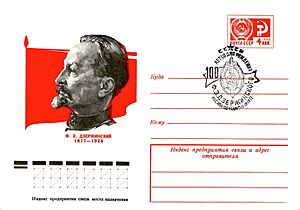
One of the two Polish Autonomous Districts in the Soviet Union was named Dzierżyńszczyzna in his honor. It was in Belarus, near Minsk. This district was created in 1932. Its capital was Dzyarzhynsk, close to Dzerzhinsky's family estate. The district was later closed in 1935.
The highest point in Belarus, Dzyarzhynskaya Hara, was named after Dzerzhinsky in 1958. His name and image were used widely in the KGB and the Soviet Union. Many places were named after him. There is a city called Dzerzhinsk in Russia. Other cities in former Soviet countries also bore his name. For example, in Ukraine, some cities changed their names back to their old names after communism ended.
The Dzerzhinskiy Tractor Works in Stalingrad was named after him. This factory was a site of heavy fighting during World War II. The FED camera, made for many years, was also named after him. So was the FD class steam locomotive.
During the Communist era in Poland (1945–1989), Dzerzhinsky was seen as a socialist hero. In 1951, a large statue of Dzerzhinsky was put up in Bank Square in Warsaw. The square was named Plac Dzierżyńskiego. But on November 16, 1989, the statue was pulled down. This marked the end of communism in Poland. The square was then renamed Plac Bankowy.
The "Iron Felix" Statue
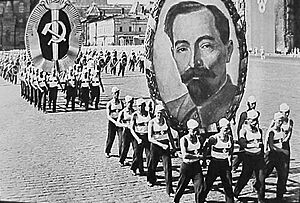
A 15-ton iron statue of Dzerzhinsky was a famous landmark in Moscow. It stood in Lubyanka Square, near the KGB headquarters. This statue was also known as "Iron Felix." It was made in 1958 by Yevgeny Vuchetich. In 1990, a memorial to victims of forced labor camps was placed next to it.
In August 1991, after a failed attempt by some communists to take control, the Moscow Soviet had the Dzerzhinsky statue removed. It was moved to the Fallen Monument Park. A copy of the statue's removal can be seen at the International Spy Museum in Washington, D.C.
The idea of Dzerzhinsky is still debated in Russia. Between 1999 and 2013, there were several suggestions to put the statue back. But these ideas were rejected. People worried it would cause "unnecessary tension" in society. A 2013 poll showed that 46% of Russians wanted the statue back. The statue remained in a yard for old Soviet memorials.
In 2012, Moscow authorities said they would fix the "Iron Felix" monument. They also called it a cultural heritage object. In 2021, it was announced that the statue's removal had no legal basis. Finally, on September 11, 2023, the monument was put back up. This time, it was placed in front of the Russian Foreign Intelligence Service headquarters outside Moscow.
Other Statues
- A smaller statue of Dzerzhinsky was put back in the courtyard of the Moscow police headquarters in 2005.
- A 10-foot bronze copy of the original "Iron Felix" statue was placed in Minsk, Belarus, in 2006.
- In 2017, a monument to Dzerzhinsky was put up in the city of Ryazan, Russia. This was for his 140th birthday.
- On January 20, 2017, a Dzerzhinsky statue was unveiled in Hanoi, Vietnam.
Dzerzhinovo: His Birthplace
In 1943, the manor house of Dzerzhinovo, where Dzerzhinsky was born, was destroyed. Family members, including Dzerzhinsky's brother Kazimierz, were killed. This happened because they supported the Polish Home Army. In 2005, the Government of Belarus rebuilt the house. It is now a museum. The graduating class of their KGB academy holds its yearly swearing-in ceremony there.
See also
- Chronology of Soviet secret police agencies
- Chekism
- "Dzerzhinsky Division" of the Soviet Internal Troops
- Felix Dzerzhinsky Guards Regiment
- Monument to F. E. Dzerzhinsky in Taganrog
- Provisional Polish Revolutionary Committee
- Polish Autonomous District
- Kang Sheng


